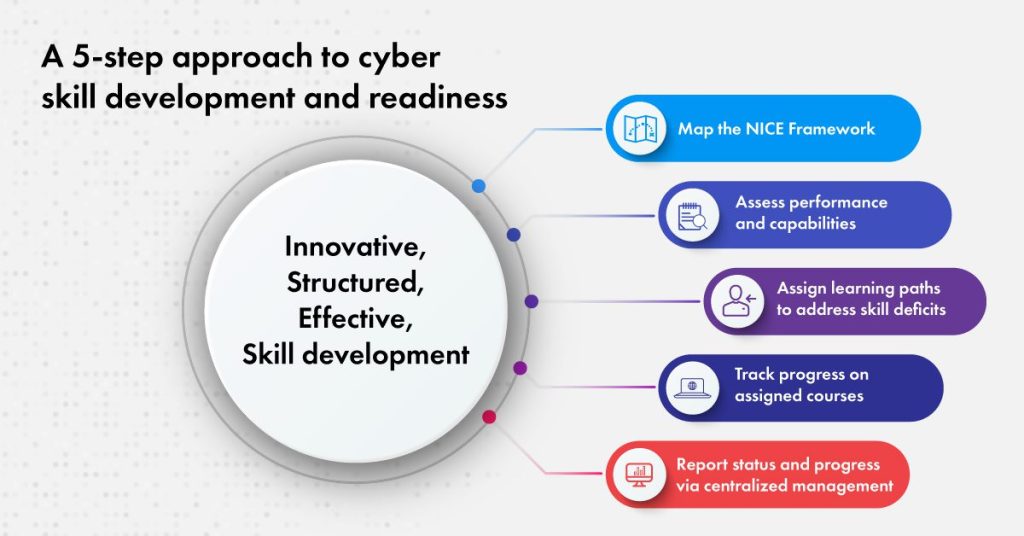NICE KSA&Ts Have Defined the Way we See Cybersecurity Skill Development
The National Initiative for Cybersecurity Education (NICE), led by the National Institute of Standards and Technology (NIST), is a partnership between the academic, government and private sector focused on developing cybersecurity education and workforce talent. Knowledge, Skills, Abilities and Tasks (KSA&Ts) statements are the core building blocks of the NIST NICE Framework and a fundamental reference for describing cybersecurity work. As a keystone of cybersecurity skills development and cyber readiness, KSA&T statements have defined the way we see and approach cybersecurity skill building and training. They provide a common language that formalizes cybersecurity job roles and their relevant skills, knowledge, abilities, and tasks, and have been adopted by the public sector, private sector and academia.
Making NICE KSA&Ts Work for You
Higher education institutions and students can use KSA&Ts as a guide for cybersecurity skill development and introducing cybersecurity careers, job seekers for demonstrating competencies, SOC/incident response teams for accomplishing tasks, and both the public and the private sectors for recruiting, identifying, measuring, developing, and retaining talent.
However, the large number of KSA&Ts and their level of detail as well as the lack of cybersecurity experts who can make use of the NICE Framework introduces a challenge to mapping them to skill development paths. Further, for SOC/IR team managers to accurately understand if an individual is the right fit for a role, identify the strongest and weakest members of the team, and observe changes over time, they must be able to track, benchmark, and manage skill development progress.
Skill Development – The Five Steps for Acing KSA&Ts
An innovative and structured approach to cyber skill development and readiness enables organized management and progress tracking of work roles and KSA&Ts. With centralized, effective management and planning, organizations can gain insights into employee skills, competencies, and knowledge, align them with specific roles and responsibilities, identify skill gaps, offer targeted training and development programs, and ensure greater cyber readiness.

1. Map – The NICE framework lists the knowledge skills and abilities needed to successfully complete cybersecurity tasks. Mapping cybersecurity skill development courses and programs to NICE work roles and their corresponding KSA&Ts ensures competencies can be mastered and enables focused learning and skill support interventions.
2. Assess – To correctly identify the KSA&Ts that exist versus those needed, you must capture data that will provide actionable metrics. This can only be achieved through automatic performance-based, granular assessment. Automatic, performance-based assessments enable routine
evaluation of individual capabilities and team performance and make it easier to determine if an employee is fit for a specific role.
3. Assign – Educators and team leaders must be able to assign employees or trainees skill development courses that address their skill deficits and plan development paths for them that meet the organization’s needs. The best-case scenario allows for both out-of-the box mapped courses and a customizable option where courses can be mapped according to the organization’s or institution’s own definitions. Assigned courses should follow a coherent learning path that builds a theoretical foundation, individual hands-on skills, and team skills.
4. Track – Real-time, continuous progress-tracking capabilities are crucial to garnering insight into strengths and areas for improvement. Tracking the status of the assigned skill development courses enables routine and accurate evaluation of an individual’s investigative capabilities, response actions, and theoretical knowledge.
5. Report – Effective skill development requires visibility into individual and team performance. Visibility should be centralized and manageable so that the status and progress of each team member can be monitored, compared, and benchmarked.
Time to Lean In to KSA&Ts
Every organization on the planet has skin in the game when it comes to cybersecurity and cyber readiness. The World Economic Forum’s Global Risk Report 2023 ranked cybercrime and cyber insecurity as a top-10 global risk within a two- and ten-year period. The same report also found that 91% of business and cyber leaders believe that a far-reaching, catastrophic cyber event is somewhat likely in the next wo years. A safe and secure cyberspace built with elite cybersecurity talent is foundational to an organization’s online security, but it is not a one-time effort. By leaning in to NICE KSA&Ts statements for workforce and cybersecurity skill development, employers, learners, and education, training, and credential providers can improve their recruitment, upskilling, reskilling, and retention practices.
Schedule a demo to learn how Cyberbit aligns cyber skill development with NICE KSA&Ts

